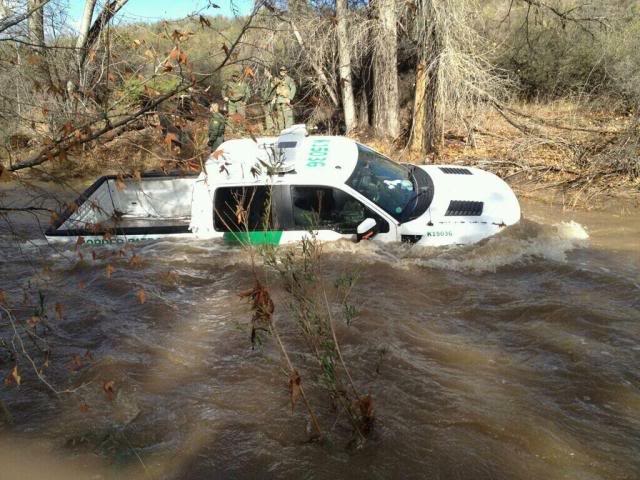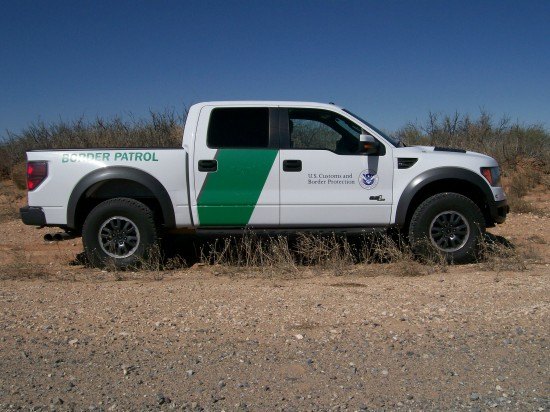Capsule Review: Ford SVT Raptor – United States Border Patrol Edition
I’m driving down a narrow dirt track somewhere in a South Texas at a hurried but not unreasonable pace. As I round a bend, the ground arches up into a tall “whoop” just a few meters in front of me. I can’t go around it, and hitting the brakes will only send me skidding into it at nearly the same speed.
Until now, I’ve mostly driven the Ford Super Duty, in F250 or F350 guise, while on patrol. They can be surprisingly capable out here in the desert, but they don’t like to be driven fast on rough terrain. Hitting one of these “Border Patrol speedbumps” at anything above a cautious crawl transforms the cabin into a world of violence as the industrial suspension crashes to the stops and your head crashes into the ceiling. I brace for the inevitable.
Moments later, I’m past it and all is well. My ass never left the seat cushion, and as far as I can tell, my tires never left the ground. Hell, even my water bottle is still resting serenely in the cupholder where I left it. There’s a reason for that. Today I’m not in a Super Duty. Today, I’m in a Raptor.
I wonder if a couple engineers sat down in Dearborn one day and said, “How bout we design the perfect truck for the U.S. Border Patrol?” It wouldn’t be an enviable job. Our trucks are operated in the some of the roughest conditions faced outside of pure military duty, and they have to withstand those conditions every day. They are piloted over steep, rocky mountain roads; across expanses of deep, soft sand that will trap you in place if you apply just a bit too much or too little throttle; through patches of dense, wet clay that wraps itself around your tires in thick, slick layers. They are driven by adrenaline junkies who are not financially liable for their repair or maintenance, and whose supervisors don’t particularly care how much unnecessary abuse is hurled at the chassis so long as you don’t dent the bodywork. We ask a lot, often way too much, of our fleet.
Our mildly modified Chevrolet Tahoe and Ford Super Duty vehicles can do almost all the things the Ford SVT Raptor is capable of doing. The difference is the ease (and speed) with which the Raptor does them. Where a Tahoe scrabbles up a steep slope, struggling to find purchase in loose rock, the Raptor simply ascends. Where an F350 churns through soft sand, fighting to keep its massive bulk afloat, the Raptor seems to glide over the surface. Our other trucks can be made to work in this environment, but the Raptor is to the manor born.
Every component on the Raptor is intended to be used this way, under these conditions. Anecdotally at least, this means fewer repairs due to parts being pushed beyond their limits. Even if an agent is not willfully abusive towards his mount, conditions in the desert sometimes require that one drive less than lovingly. Getting across a flooded ditch or a patch of large rocks often requires a bit of momentum going in. I’ve seen this technique result in shattered suspension components, dislodged coolant and/or turbo plumbing, busted oil pans, and dented rims.
Not with the Raptor. I’ve yet to see a single one sidelined for damage caused by routine overuse. That’s not to say we haven’t “deadlined” a few; if you want to find a product’s limits, give it to a Border Patrol Agent. The Patrol has determined that the Raptor will not float across a running arroyo during monsoon season. Also, if you have too much fun playing with the included inclinometer display, it will roll sideways down a mountain. Yet to my knowledge, not even our wildest/dumbest agents have managed to bend the frame on one.
We have other trucks that can give the Raptor a run for its money in some circumstances, but none of them do it without significant compromise. The Jeep Wrangler Rubicon’s short wheelbase is a delight when crawling through narrow canyons and up tight switchbacks, but it gets skittish when you have to dial in a bit more speed. The old HMMWV/Hummer H1 can bash its way across any landscape, but it is deeply unpleasant in every other regard and driving them makes me feel sad. Also, every fluid in that venerable military vehicle will boil if it’s hot or hilly, which can be a problem in the Southwest. The Raptor may be outclassed by a particular competitor in that competitor’s one-percent scenario, but you’ll be glad to have the big Ford when you realize 99% of the drive is still ahead of you.
When duty takes us back onto pavement, this off-road savant behaves with polite road manners as well. Pin the throttle coming off a soft shoulder, and the forgiving traction control allows the rear end to kick out a bit as the exhaust plays a thunderous siren song. Disappointingly, the government doesn’t trust us enough to remove the 98 MPH electronic limiter, but the Raptor will get to that limiter in a big damn hurry for such a big damn truck.
Fortunately, the typical smuggler’s vehicle is a circa 1997 Ford Expedition or Chevrolet Suburban loaded well beyond the manufacturer’s recommended GVWR, so 98 is usually fast enough. On an open road, the Raptor will only begrudgingly do anything under 90, the quiet cabin and stable handling cutting your perceived speed about in half. On the rare occasion that the Southwestern hardtop gets twisty, Ford’s desert racer inspires more confidence than most vehicles in the 3-ton+ class. The suspension resists leaning too far into its twelve inches of travel as the 315mm BFGoodrich All-Terrains brace against the pavement and the lateral momentum shifts smoothly from one side to the other. Your average driver will have found his way off the road, through a fence, and into a tree long before a pursuing Raptor hits its limits.
Beyond the apparent savings in repair costs, purchase costs look pretty favorable as well. An F-250 built to standard Border Patrol spec, with the PowerStroke turbodiesel engine and an extended cab, goes for $44,710 according to Ford’s configurator. A base 4×4 Chevy Tahoe stickers over $50,000 nowadays. A 2014 Raptor starts at $44,995, and it requires no additional options for our purposes. Frankly, I’m not sure why the Patrol has purchased anything else since the Raptor arrived in 2010. SVT is taking a hiatus from the OEM off-roader game for the 2015 and 2016 model years, but they’ve already announced the Raptor will return with a lighter, aluminum-clad successor as a MY 2017. The 6.2L V8 will be retired in favor of a tuned 3.5L EcoBoost V6 producing more power and torque than its naturally aspirated ancestor. I can only expect that the price will rise proportionately, I just hope it remains within reach of the U.S. federal government and its humble civil servants like me. Does Uncle Sam qualify for 90 month financing?
More by Ur-Turn
Latest Car Reviews
Read moreLatest Product Reviews
Read moreRecent Comments
- MaintenanceCosts Poorly packaged, oddly proportioned small CUV with an unrefined hybrid powertrain and a luxury-market price? Who wouldn't want it?
- MaintenanceCosts Who knows whether it rides or handles acceptably or whether it chews up a set of tires in 5000 miles, but we definitely know it has a "mature stance."Sounds like JUST the kind of previous owner you'd want…
- 28-Cars-Later Nissan will be very fortunate to not be in the Japanese equivalent of Chapter 11 reorganization over the next 36 months, "getting rolling" is a luxury (also, I see what you did there).
- MaintenanceCosts RAM! RAM! RAM! ...... the child in the crosswalk that you can't see over the hood of this factory-lifted beast.
- 3-On-The-Tree Yes all the Older Land Cruiser’s and samurai’s have gone up here as well. I’ve taken both vehicle ps on some pretty rough roads exploring old mine shafts etc. I bought mine right before I deployed back in 08 and got it for $4000 and also bought another that is non running for parts, got a complete engine, drive train. The mice love it unfortunately.















































Comments
Join the conversation
Needs a .50 cal...
They mangled the front bumper on that Raptor. I try to use my Raptor as advertised every weekend hitting the speed limiter of road is good fun, but yah the tires are the limiting factor. so only going to 100mph but ford has told me that my truck has had over speed indicated in the computer and they think its from getting air at the top speed.